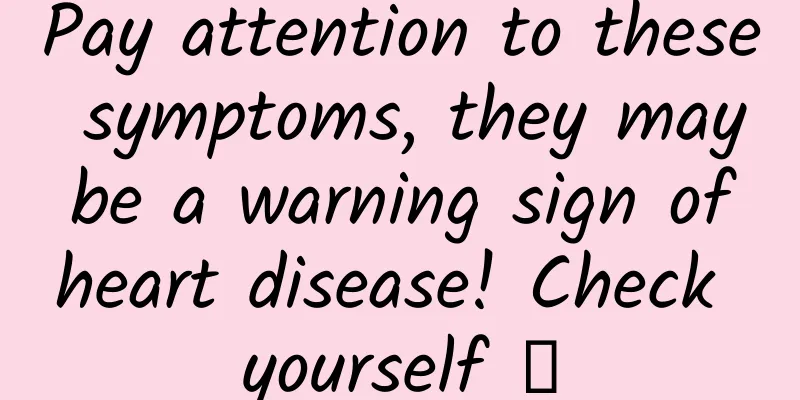Pay attention to these symptoms, they may be a warning sign of heart disease! Check yourself →

|
In recent years, there have been frequent reports of sudden death, many of which are related to heart disease, and the population tends to be younger. According to the "China Cardiovascular Health and Disease Report 2020" released in July 2021, as of 2018, the mortality rate of cardiovascular disease in my country still ranked first. In fact, before cardiovascular disease occurs, our body often gives early "warnings" and sends out many signals, including physical discomfort and changes in body shape, appearance, color, etc. If we recognize this abnormality early at home and go to the hospital as soon as possible, we will receive timely treatment and get the best prognosis. This article excerpts part of the book "Intimate: Cardiologists Teach You Professional Heart Care" to take a look at these six "warnings" that appear before heart problems occur. 1. Thick ends of fingers and toes Clubbing (also known as "drumstick fingers") is characterized by hyperplasia, hypertrophy, and club-shaped enlargement of the ends of fingers or toes. Its characteristics are that the terminal phalanges (toes) are significantly widened and thickened, and the nails (toes) are arched from the root to the end, so that the base angle formed by the skin on the back of the finger (toe) and the nail (toe) is ≥180°. What disease does clubbing indicate? Clubbing means that blood is shunted when it flows through the heart. It is a manifestation of chronic hypoxia in the body and can be seen in many diseases such as cardiovascular and respiratory diseases. Indicating possible cardiovascular diseases: chronic heart failure, rheumatic heart disease, subacute bacterial endocarditis, infectious myocarditis, pericarditis; cyanotic congenital heart diseases, such as tetralogy of Fallot, total anomalous pulmonary venous drainage, pulmonary arteriovenous aneurysm, etc. How to identify clubbing? By comparing the following details, you can quickly check whether you have clubbing. Appearance comparison Comparison of the appearance of normal fingers and clubbed fingers Normal finger from above and from the side (left) vs clubbed finger from above and from the side (right) Nail edge angle comparison The left finger shows normal lateral aspect (∠ABC=169°) and nail angle (∠ABD=183°) vs the right clubbed finger with angles of 191° and 203° respectively Phalangeal depth ratio Normal nail IPD is greater than DPD vs. Clubbing finger DPD is greater than IPD Schamroth phenomenon In the absence of clubbing, the two index fingers are placed against each other, and a diamond-shaped gap is formed between the nails. In clubbing, the nail bed tissue is increased, resulting in the gap being closed. 2. Recurrent tonsil infection If you have symptoms such as palpitations, chest tightness, chest pain, fever, and a history of repeated tonsil infections (this mainly occurs in adolescents), you should pay attention to the possibility of rheumatic heart disease or myocarditis, and should go to a cardiologist for treatment and consider tonsillectomy. 3. Syncope If you experience fainting at home, in addition to seeing a neurologist, you should also consider whether it is caused by heart disease. Characteristics of syncope caused by heart disease: sudden fainting and loss of consciousness, which lasts for a short time (only a few minutes), followed by rapid recovery, clear consciousness after recovery, and no memory loss. Copyrighted stock images, reprinting and using may cause copyright disputes 4. Cough and the following symptoms We all know that cough is one of the most common manifestations of respiratory diseases. However, what is often overlooked is that cough can also be a sign of heart disease. Especially when the cough does not get better or heal after visiting the respiratory department. 1 Infants and children The most common cause of cough is upper respiratory tract infection, but congenital heart disease should also be ruled out. First, the child is young and cannot accurately express discomfort in words, so coughing may be used instead; second, coughing is one of the common symptoms of congenital heart disease, and some severely ill children may also have hemoptysis. Copyrighted stock images, reprinting and using may cause copyright disputes 2 Adult patients Coughing accompanied by chest tightness or hemoptysis may be a manifestation of mitral stenosis or regurgitation, pericarditis, or even a cardiac tumor. Cough accompanied by fever requires exclusion of the possibility of infective endocarditis. If there are symptoms of coughing and expectoration, and the sputum is clear, watery, foamy, or pink, then the possibility of heart failure should be considered. Such patients often also have difficulty breathing or even inability to lie flat, and edema of both lower limbs. If coughing is accompanied by unexplained hoarseness, the rare possibility of aortic aneurysm compressing the recurrent laryngeal nerve should be considered. 5. Abnormal pulse pressure in both arms The pulse pressure of both arms refers to the difference between the blood pressure values of the left and right arms of a person. How to measure the blood pressure of both arms? When you first visit a doctor, you should measure the blood pressure of the left and right upper arms. There are currently two main methods for measuring blood pressure in both arms. Method 1 uses the same sphygmomanometer to measure the blood pressure of both arms in succession. Method 2 uses two single-cuff sphygmomanometers of the same model or a double-cuff double-arm sphygmomanometer to measure the blood pressure of both arms at the same time. How to calculate the pulse pressure of both arms? The calculation method of the pulse pressure of both arms is very simple, that is, the absolute difference between the blood pressure of the left and right upper arms is used, and the two are subtracted. Under normal circumstances, the pulse pressure of both arms is generally 5-10mmHg. If it exceeds this range, it is considered abnormal pulse pressure, which is mainly seen in polyarteritis, congenital arterial malformations, etc., and may also occur in stenosis or even occlusion of the carotid artery, subclavian artery, and vertebral artery on one side. In addition, it may also occur in aortic dissection, cardiovascular malformations, upper limb vascular malformations, etc. Studies have shown that long-term pulse pressure of both arms ≥5mmHg is significantly associated with all-cause mortality and cardiovascular mortality. For every 5 mmHg increase in pulse pressure in both arms, the incidence of cardiovascular events increases by 3%. Once abnormal pulse pressure in both arms is found, go to a regular hospital for further examination (such as arterial color Doppler ultrasound, CTA) as soon as possible. 6. Atypical symptoms The following atypical cardiovascular disease symptoms may indicate angina attacks and acute myocardial infarction. Middle-aged and elderly people, women and diabetic patients should pay special attention. Symptom 1: Sudden profuse sweating: Sudden profuse cold sweat without exercise, eating, drinking water, and the environment is not hot. Symptom 2: Tightness in the precordial area, chest tightness, wheezing, and difficulty breathing: Symptoms occur paroxysmically and worsen when doing housework, climbing stairs, exercising, or going out. Symptom three: indigestion: frequent episodes of hiccups, belching, acid reflux, bloating, early satiety, etc., especially when there is no history of digestive system diseases. Symptom 4: Tightness in the pharynx and back of the neck. Symptom 5: Local pain that has not received enough attention: headache, toothache, back pain, shoulder pain, upper abdominal pain, upper arm pain, etc., especially when the pain occurs suddenly and is unbearable. Tips If the above symptoms are paroxysmal and last for a few minutes to ten minutes before being relieved on their own, it is most likely caused by angina pectoris. If the above symptoms persist for more than ten minutes or even dozens of minutes and cannot be relieved, then you must be alert to the occurrence of acute myocardial infarction and need to seek medical attention immediately. "Intimate" No medical background? No professional terminology? Can't read an electrocardiogram? It doesn't matter! Professor Ren Jingyi's team at the China-Japan Friendship Hospital will teach you how to protect your heart professionally. This book starts with understanding the structure of the heart, helping readers master the method of self-assessment of heart health, familiarize themselves with the diagnosis and treatment process of heart disease, and thus enhance their awareness and ability to prevent heart disease. The author uses vivid words to introduce the cardiovascular system in detail, as well as how to deal with and prevent cardiovascular system failures. In response to professional issues that often puzzle people, such as disease sign warning, self-help for critical illness, medical procedures, medication standards, follow-up visits, interpretation of tests and examinations, and daily health care, the book provides readers with thoughtful answers through basic explanations, warm reminders in the form of tips, or recreates the situation of "consultation with a cardiologist". This is a popular science guide that can help you understand your heart clearly, prevent heart disease, learn self-screening and seek medical treatment. If you care about your health and want to stay away from heart disease, this is the book for you. Planning and production Source: Book "Intimate: Cardiologists Teach You Professional Heart Care", Science and Technology Press of China Planning丨He Tong Editor: He Tong Proofread by Xu Lai and Lin Lin |
>>: How many of these rumors about milk do you believe?
Recommend
When is the best time for abortion?
If a woman becomes pregnant unexpectedly without ...
How does TCM treat gynecological diseases? Treatment methods for common gynecological diseases
In modern life, due to the fast pace of life and ...
What is the concentration of soda water rinse?
More and more people pay attention to flushing wi...
Baofeng Mojing & Zhimeng Consulting: China VR User Behavior Research Report
On March 18, 2016, at the 12th TFC Global Mobile ...
Cold wave! The temperature has dropped drastically. Remember to remind your parents these 5 things
Cold is like a hidden killer, targeting the cereb...
What is the normal size of the gestational sac at eight weeks of pregnancy?
The gestational sac is the earliest sign of early...
What to do if red bumps and itchiness appear on the body during confinement
After giving birth, women are weak, so they need ...
You don’t need a major blood transfusion to regain your youth, just add some water to the blood?
Studies have found that thinning the blood can re...
If your abdomen is always bloated and painful, and you can't find the cause, it may be a "heart disease"
A friend left a message to Huazi, saying that he ...
What should I do if my belly swells during my fourth month of pregnancy?
Pregnancy is supposed to be a very happy thing be...
What should I do if I have breast pain or lumps?
To effectively relieve breast pain and lumps, you...
The best way for girls to train their abdominal muscles
For girls, if they want to train their abdominal ...
24 years old flat chest
Female breast development usually occurs during p...
How to take good photos of the sea of clouds? What camera should I use to take photos of the sea of clouds?
The sea of clouds is a very spectacular natural...
Experts answer: Can you have sex if you have cervical erosion?
The degree of cervical erosion can be divided int...









